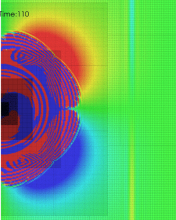
Abstract
We study the convergence properties of our implementation of the moving punctures approach at very high resolutions for an equal-mass, nonspinning, black-hole binary. We find convergence of the Hamiltonian constraint on the horizons and the L2 norm of the Hamiltonian constraint in the bulk for sixth- and eighth-order finite difference implementations. The momentum constraint is more sensitive, and its L2 norm shows clear convergence for a system with consistent sixth-order finite differencing, while the momentum and Baumgarte-Shapiro-Shibata-Nakamura (BSSN) constraints on the horizons show convergence for both sixth- and eighth-order systems. We analyze the gravitational waveform error from the late inspiral, merger, and ringdown. We find that using several lower-order techniques for increasing the speed of numerical relativity simulations actually lead to apparently nonconvergent errors. Even when using standard high-accuracy techniques, rather than seeing clean convergence, where the waveform phase is a monotonic function of grid resolution, we find that the phase tends to oscillate with resolution, possibly due to stochastic errors induced by grid refinement boundaries. Our results seem to indicate that one can obtain gravitational waveform phases to within 0.05 rad. (and possibly as small as 0.015 rad), while the amplitude error can be reduced to 0.1%. We then compare with the waveforms obtained using the CCZ4 formalism. We find that the CCZ4 waveforms have larger truncation errors for a given resolution, but the Richardson extrapolation phase of the CCZ4 and BSSN waveforms agrees to within 0.01 rad, even during the ringdown.